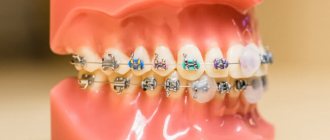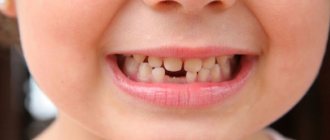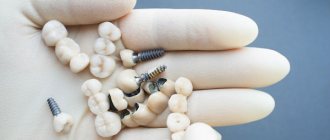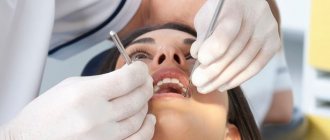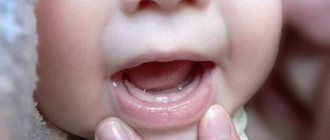A child’s teeth are deteriorating - what to do?
A child’s teeth deteriorate: reasons.
What factors worsen the health of baby teeth?
If a child’s teeth deteriorate, what should I do?
Unfortunately, many children have dental problems. As a rule, this causes trouble not only for parents, but also for the baby himself. For example, if a child’s teeth are deteriorating, then parents must make an effort to find the cause and eliminate it in time.
Supernumerary or hyperdontia
The photo shows dental hyperdontia
Not only children’s permanent teeth can erupt in the second row, but also milk teeth. Here we are usually talking about supernumerary (hyperdontia) - for example, if not 4 central incisors on the lower (or upper) jaw have erupted, but 5 or more. Simply put, these are “extra” teeth that normally should not exist.
This anomaly is observed in 2 people out of 100 - both in the primary and permanent dentition. And in most cases, it does not cause inconvenience in adulthood. If, of course, there is enough space in the dentition for everyone - i.e. The “extra” element gradually moved from the second row to the first.
In young children, the jaw cannot always accommodate the “extra”, so food begins to get stuck and caries forms.
We invite you to familiarize yourself with the process of wisdom tooth extraction and subsequent restoration.
A child’s teeth deteriorate: reasons
The most common problems with children's teeth identified by dentists are:
- the baby’s teeth turn black or the enamel darkens in places;
- the child has fragile teeth, which is why they begin to crumble;
- active development of caries in preschool children.
Let's look at the causes of these key problems and possible ways to solve them.
A child's teeth deteriorate for various reasons. The main ones:
- exposure to aggravating factors during the period of intrauterine development of the fetus (severe and prolonged toxicosis during pregnancy, impaired or insufficient nutrition of the expectant mother, necessary or careless use of certain medications);
- if a baby under the age of one year was given intensive antibiotic therapy;
- insufficient dental care and, as a consequence, the development of early caries;
- insufficient absorption of calcium;
- permanent and persistent dental plaque;
- hereditary predisposition (individual characteristics of enamel);
- limited salivation;
- chronic diseases. For example, gastritis with high acidity makes tooth enamel more susceptible to caries. This is explained by the fact that increased acidity affects the absorption of calcium and phosphorus;
- dysbacteriosis;
- the presence of a large amount of foods and drinks containing sugar in the child’s diet;
- impaired metabolism;
- exchange of bacteria between parents and child (for example, when sharing cutlery);
- unformed children's enamel.
Dark spots on the enamel may indicate that caries has begun to develop. If you start this process, caries will penetrate even deeper into the tooth. Due to the special structure of the pulp, destructive processes spread very quickly: for example, caries can turn into pulpitis in just a few months.
Rotten teeth in children and adults: photos, reasons, what to do
Let's move on to the next, no less important point in our topic today - rotten teeth in children and their consequences for the body.
If the baby has problems at the stage of growth and formation of temporary teeth, there is every chance that the permanent teeth may grow incorrectly and you will have to spend a lot of time, nerves and money on corrections from the orthodontist. Dental problems affect many other processes - digestion, the likelihood of developing rheumatic infections and even the risk of heart problems. After all, pathogenic flora has the ability to spread throughout the body, destroying everything in its path.
Child at the dentist
However, when staphylococcus and other dangerous types of microorganisms that cause tooth decay multiply in your body, it is a serious threat to your health. A child does not have such a powerful immune system as an adult. Therefore, if you discover he has dental problems, take care of it now, before the problem develops into something more dangerous.
If you find signs of caries or problems with tooth enamel in your baby, immediately take him to pediatric dentistry. At the initial stage, it is much easier to combat the manifestation of caries. Now there are a lot of gels and varnishes with fluoride designed specifically for children. They allow you to stop the dangerous processes of tooth decay.
4 stages of development of dental caries
Pacifier
No night feedings. You upset the balance in your mouth. At night, saliva protects teeth from destruction by bacteria. If you provide a source of carbohydrates, which are excellent food for harmful flora, this will contribute to the development of tooth decay.
If complicated caries is detected, which does not allow restoration of a temporary tooth with a filling, its immediate removal is recommended. Otherwise, the carious process can affect deeper tissues, including the developing permanent tooth.
Girl at the dentist
Talk to your doctors about healthy eating. Ask what to add to your baby’s food so that he receives all the substances necessary for healthy teeth.
Rotten baby teeth in children need to be treated at an early stage of the development of the process. Otherwise, the baby may be left without teeth much earlier than nature intended. If this affects the development of permanent teeth, he may experience malocclusion and malformation in the future (trema and diastema, other defects). This can lead not only to cosmetic, but also to psychological problems in the foreseeable future.
Baby teeth rot
Even if the baby is capricious or throwing a tantrum, this is not a reason to leave everything as it is. It will only get worse. After all, once the destructive process reaches the pulp, inside which the nerves of the tooth are located, the problem will be further complicated by severe pain. In modern pediatric dentistry, as I said earlier, there are many ways to carry out procedures painlessly for the child.
I wish that neither you nor your kids ever have problems with teeth. If they arise, may everything be resolved quickly and without complications. For treatment of gum inflammation, read our article.
In adults, enamel decay is also associated with caries, but it usually begins to develop on premolars and molars - the incisors are less affected. Factors that lead to the development of caries on permanent teeth include:
- sick teeth in an adult. Childhood caries. The disease, which develops on primary incisors, canines and molars, can affect the already formed rudiments of permanent ones. Therefore, it is impossible to ignore terrible, rotten teeth in children, even though they will be replaced by permanent ones.
- Improper or irregular oral hygiene.
- Poor nutrition, in which the body receives a minimum amount of coarse fiber - fiber.
- Lack or excess of certain nutrients in the diet of an adult.
- The presence of diseases of the gastrointestinal tract that affect the absorption of nutrients.
- Decreased immunity, promoting the development of pathogenic microorganisms.
In dentistry, caries is classified into superficial, medium and deep. The picture below shows their comparison.
In both adults and children, the onset of caries is indicated by increased tooth sensitivity to cold or hot. Sometimes diseased incisors, canines and molars ache when chewing solid food.
With deep caries, toothache occurs every time food or liquid gets on the affected area of enamel. The patient develops a putrid odor from the mouth, which is felt within a few hours after brushing the teeth.
You should not wait until the hard dental tissue completely rots and your teeth begin to hurt constantly. If you go to the dentist at the initial stage of the disease, you can get rid of it using simple methods that do not require anesthesia and partial or complete removal of a rotten incisor, fang or molar.
carious process in the spot stage
the initial stage of the carious process
middle stage of the carious process
deep carious process
There are several treatment options for rotten primary incisors, canines and molars. The choice of the appropriate method depends on how long ago the tooth ached and how advanced the situation is.
What to do if your child’s baby teeth are rotting:
- Fluoridation is used to treat the initial stages of carious lesions. With it, the scary, black teeth of the little patient are covered with a special varnish with a high fluoride content, thanks to which the enamel layer is restored and the development of the disease stops. Fluoridation is commonly used to restore anterior incisors.
- The most effective method for treating caries is ICON. It helps restore even unhealthy black teeth, the main thing is that the destruction affects only the enamel. Using this method, the pediatric dentist removes dental tissues with rot, and in their place applies a special composition, which can be seen in the picture on the right. At the end of the procedure, the composition is dried to make it as durable and invisible as possible.
- In the most advanced cases, terrible children's teeth are simply filled, but only glass ionomer cements are used for this. They will be erased along with the natural hard tissue, and therefore will protect the little patient from discomfort until the period of change from primary to permanent bite. An example of such a seal is shown in the photo below.
In adulthood, anesthesia can be used, so the list of acceptable methods for treating caries is expanding. In the early stages of the disease, fluoridation of the enamel is used, and in advanced forms of the disease, diseased dental tissues are removed and filling is performed.
To restore the appearance and functionality of poor permanent incisors, canines and molars, different types of fillings are used. The most popular options:
- photopolymer;
- glass ionomer;
- ceramic;
- amalgam;
- plastic.
In modern dental clinics, photopolymer fillings are most actively used, which harden only under the influence of a special spectrum of light. The finished filling looks very natural and can withstand serious mechanical stress, but it is expensive - from 2 thousand rubles. The installation process is shown in the picture.
Glass ionomer fillings are in second place in popularity. They cost a little less than photopolymer ones, but they wear out very quickly: every 2 years they have to be made again.
Ceramic fillings are almost impossible to distinguish from natural enamel; in terms of strength, they are also much better than all other options. But still, ceramic filling materials are rarely used, since high prices are set for them - from 15 thousand rubles.
Amalgam fillings are made from a unique metal alloy. An example of a molar restored using such a filling material is shown in the photo below. Looking at it, it becomes clear why amalgam fillings are not very popular.
Acrylic fillings are also not very common. They look as natural as possible, but become unusable in a matter of months.
There are many ways to combat rotting of incisors, canines and molars. But it is better not to start the disease and eliminate it at the initial stage of development, when tooth restoration does not require removing rotted tissue and installing a filling.
The enamel of baby teeth is quite thin and fragile, which means it is especially susceptible to various lesions and destructive processes. Therefore, rotten teeth in children are by no means a rare phenomenon, but on the contrary, very common.
Enamel begins to rot for various reasons, but most often such processes are associated with poor hygiene and poor nutrition.
The situation is further complicated by the fact that many parents do not consider it necessary to take care of temporary teeth too seriously, explaining that they will soon be replaced with permanent ones.
Poor oral hygiene leads to diseases of baby teeth
This is a big mistake that can result in a lot of problems for the child in the future.
The fact is that destructive processes, if left untreated, very quickly spread to neighboring tissues, penetrate deeper and affect internal structures.
As a result, the infection reaches the rudiments, and then you don’t have to wonder why the tooth is already sick. Therefore, it is imperative to treat your teeth, and the sooner you start, the higher the chance of avoiding serious consequences.
Why can a child’s enamel begin to rot and what can be done about it? Experts cannot yet give an exact answer to this question due to the abundance of risk factors that can provoke the development of putrefactive processes. They can begin in a child at the age of 3, and in other cases the teeth appear with characteristic suppuration. Among the reasons that can cause this kind of enamel damage, experts identify the following:
- improper cleaning technique or complete lack of oral hygiene: it is for this reason that rot most often forms,
- constant consumption of unhealthy foods: abuse of sweets - the problem often arises from sweets, chocolate and other foods high in sugar. The situation is aggravated by the lack of sufficient vitamins and beneficial microelements in the diet,
- prolonged consumption of water with low levels of fluoride,
- living in unfavorable environmental conditions, severe air pollution,
- genetic predisposition,
- damage to the crown as a result of mechanical impact,
- advanced caries as a cause of the formation of rot in the oral cavity.
- Fluoridation is used to treat the initial stages of carious lesions. With it, the scary, black teeth of the little patient are covered with a special varnish with a high fluoride content, thanks to which the enamel layer is restored and the development of the disease stops. Fluoridation is commonly used to restore anterior incisors.
- The most effective method for treating caries is ICON. It helps restore even unhealthy black teeth, the main thing is that the destruction affects only the enamel. Using this method, the pediatric dentist removes dental tissues with rot, and in their place applies a special composition, which can be seen in the picture on the right. At the end of the procedure, the composition is dried to make it as durable and invisible as possible.
- In the most advanced cases, terrible children's teeth are simply filled, but only glass ionomer cements are used for this. They will be erased along with the natural hard tissue, and therefore will protect the little patient from discomfort until the period of change from primary to permanent bite. An example of such a seal is shown in the photo below.
What factors worsen the health of baby teeth?
- Mechanical factors: impacts, bruxism, strong compression. They lead to changes in the tooth and disruption of its integrity.
- Chemical factors: prolonged exposure to sweets on the loose enamel of children's teeth.
- Bacterial factor: the spread of bacteria in the baby’s mouth.
- Sudden temperature changes when eating or drinking.
Why should caries in primary teeth be treated?
It is a mistake to think that baby teeth do not require treatment. Tooth decay is a disease caused by the growth of bacteria in the mouth. It weakens the immune system, and this leads to frequent illnesses in the child.
Tooth irritation from food forces the child to spare the affected side when chewing, which can disrupt the bite for life.
Consequences of refusing treatment:
- Maintaining a focus of chronic infection. From the oral cavity, bacteria can spread to the ENT organs, the digestive tract, the lungs and even lead to sepsis.
- Violation of the formation of permanent teeth. Unrecognized deep caries has a negative effect on the rudiments of permanent teeth. As a result, they grow up weakened or already affected by caries.
- Violation of the integrity of the dentition. In the absence of timely treatment, children quickly develop pulpitis. Such teeth are removed, the integrity of the dentition is damaged, and the bite changes.
If a child’s teeth are spoiling, what to do?
It is important for parents to understand that enamel is the main protection, the stability and structure of which depends on hereditary factors and on the saliva that washes the surface of the teeth. If the composition of saliva is disturbed because the child does not receive enough vital nutrients and minerals, this can lead to the formation of permanent plaque on the teeth. Even with systematic and thorough cleaning, it is impossible to get rid of such plaque forever, since it will appear again and again.
If a child’s teeth deteriorate due to the disturbed composition of saliva, then this problem can be solved by adjusting the diet. The menu should be balanced. It must contain foods rich in iron, calcium and other minerals that strengthen tooth enamel: hard cheese, sesame seeds, bran, feta cheese, milk, cottage cheese, herbs, legumes. Foods rich in phosphorus are very useful: fish, cottage cheese, cod liver, shrimp, squid, beets, carrots.
However, parents’ independent actions cannot always bring results. If your child’s teeth continue to deteriorate, then it is worth making an appointment with a pediatric dentist, who will offer effective treatment methods and help stop the destructive process.
How are teeth treated for older children?
Older children are already capable of interacting with a doctor. It’s easier to ask them to open their mouth and stay in that position. They make contact with the doctor, fulfill his simple requests, and it is easier for parents to explain to the child why all these manipulations are needed.
However, it is necessary to prepare a 2-3 year old child for a visit to the dentist no less carefully. How calmly the child will behave during the examination depends on the parents’ preliminary work. Apply the following preparation methods:
- Don’t focus on going to the doctor, don’t make it a special event.
- There is no need to say that the doctor will not do anything, otherwise the baby will feel deceived, especially if the use of a drill is required. Tell them that the doctor will look at your teeth, clean them and, if necessary, treat them.
- If this is the first trip to the dentist, do not convince your child that he will not be hurt or scared. The child does not yet know what to be afraid of, and such statements will only make him wary.
- Talk about how important it is to have healthy teeth. If your child expresses fear of the doctor, ask in surprise why he should be afraid of the good doctor who helps get rid of pain.
Since an older child is ready to cooperate with the dentist, in the treatment of caries, in addition to the above, other methods are used:
- Manual processing or ART method. Areas affected by the disease are removed using instruments. The holes are filled with a special solution containing fluoride.
- Icon technology. First, the doctor removes plaque from the teeth. The carious lesions are then treated with a gel that fights pathogens. When the cavities are cleaned, the doctor fills them with a polymer, which hardens under a special lamp.
- Preparation. The most frightening method for a small patient, as it requires the use of a drill. It is used at the deep stage of caries. The cavity is opened and cleared of pus, after which it is filled with a calcium solution, and the dentist places a filling on top.
We suggest you read What to do if your tooth hurts from cold
If the child resists treatment, in rare cases general anesthesia is used. This step is taken when the disease is severe. Discuss the possible need for anesthesia with your dentist.
Treat or remove?
Is treatment necessary in such a situation or is it better to resort to extraction? Dentists believe that all treatment options should be tried before deciding to undergo surgery. Dental treatment for children during their milk maturation is absolutely necessary. Why?
- Caries spreads so quickly that you won’t have to wait long for pulpitis.
- If there is no treatment for caries, soft tissues become inflamed, and children suffer from abscesses.
- Meningitis, sepsis may develop, and large blood vessels in the neck area may be affected.
- Often children with rotten chewing organs suffer from sinusitis, otitis media, and indigestion.
- Advanced pathology leads to rapid loss of temporary units, which disrupts a number of permanent masticatory organs.
- The affected crowns look unsightly, which causes a child to become complex at 5 years old, even earlier.
In order not to miss the initial stage of the anomaly, you should regularly show your child to the dentist. He will notice the first signs of pathology in time, diagnose and prescribe therapy. Do not self-medicate, because balms, masks, and rinses will only slow down the damage to the crowns and will not eliminate the cause. Only an experienced dentist can help a child.
- First, the doctor will examine the oral cavity, determine the affected areas, and refer the patient for an x-ray.
- After analyzing the information received, a treatment regimen is drawn up and hygienic cleaning is carried out.
- If conservative technologies do not bring a positive result, surgical intervention is performed.
Special rinses are prescribed for disinfection. Antibiotics may be recommended according to indications. There are alternative treatment methods that are used for minor lesions. This includes strengthening the enamel with special mineral compounds, the use of laser beams, silvering, ozonation, and deep fluoridation.

